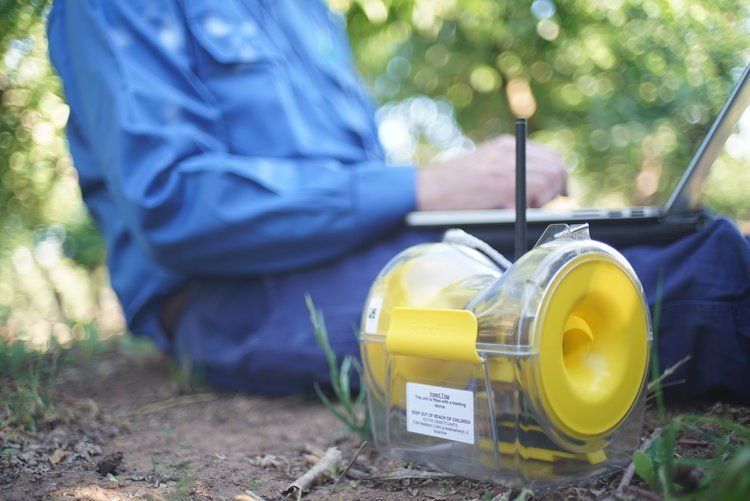RapidAIM, an Australian agtech startup that’s developing a cost-effective monitoring system for crop pests, has raised funding from Melbourne-based VC firm Tenacious Ventures. Further financial details of the funding were not disclosed, though RapidAIM co-founder and CEO Nancy Schellhorn told AFN it was a seven-figure amount.
The Brisbane-based startup was launched by Schellhorn and her co-founders Laura Jones and Darren Moore in late 2018. The trio had been research scientists at Australia’s national science agency CSIRO, where they were working on ways to monitor crop pests such as fruit fly across wide areas using wireless networking technologies.
“We were trying to solve a big challenge at CSIRO: how to take the guesswork out of crop protection. We resigned, formed our company, licensed the tech from CSIRO, and raised a seed round,” Schellhorn said.
“It was that combination of talent, ambition, and motivation that was really the impetus for us taking the risk and making the leap [into business].”
The RapidAIM team has taken the work they did at CSIRO even further by building small, mobile insect traps equipped with sensors that farmers can deploy anywhere on their land.
What makes this system different from the others out there is the way in which it identifies pests, Schellhorn said.
Rather than relying on expensive and less-mobile camera and imaging technologies, RapidAIM’s sensors are able to register unique behaviors associated with certain insect species in order to identify them when they land in the trap.
“Just like a fingerprint can unlock your phone, once an insect enters one of our traps it unlocks a sensor. The location of that insect is then logged in real time and [the system] uses narrow-band IoT to communicate that to the cloud,” Schellhorn explained.
“Part of our tech is the sensor, the other proprietary part is our ultra-low power communications platform.”
Fruit fly first, fall armyworm next
Most of the readily available, manually operated traps used to monitor insects today rely on off-the-shelf attractants – which means that a whole bunch of bugs are captured, but it’s tricky to identify precisely which ones to be worried about, she added.
“As they come into our trap, our sensors and algorithms allow us to discriminate which insects are in there and if it’s what we’re interested in.”
Other plus points, according to Schellhorn, are the power efficiency and low cost of its system, making it more affordable for a wider range of growers and therefore more scalable than camera-based solutions. Each trap can run for up to 18 months on just two small lithium-ion batteries.
They’re also easy to use and maintain – farmers simply hang the traps in their field or orchard, and receive alerts via a smartphone app when a potential pest problem is identified.
RapidAIM has so far deployed about 500 of its sensors across eastern Australia and New Zealand, serving 170 users over 450 square kilometers of farmland.
While it has initially focussed on fruit fly, the startup is now working on applying its detection platform to fall armyworm and codling moth. This will allow it to tap into both horticultural and row crop markets over the longer term.
Lowering agricultural chemical use
Schellhorn also believes that RapidAIM’s solution can have an environmental impact by reducing chemical pesticide usage, helping farmers to move away from a ‘spray and pray’ approach.
“Chemical use has to change and RapidAIM is really poised to drive this change. It basically pinpoints pests so growers can see what’s happening where and when, which increases efficiencies and massively reduces cost and loss,” she said.
“Timing is everything when it comes to pest management. It’s really a guessing game [at the moment] and insecticides are used as an insurance because growers can’t take the risk of loss. But really effective chemicals are no longer available due to this overuse problem. RapidAIM gives growers the confidence to use chemicals more judiciously and in a targeted way – and to use softer biological products.”
Because camera-based detection comes at a higher cost, farmers can’t deploy it at the density required to get an accurate, real-time picture of the pest problems they face, Schellhorn argued. This means that more targeted insecticide use is largely out of the question – in terms of both time and space.
“Some of our growers are already changing their spraying practices because [with RapidAIM] they can see the time of day insects are most active,” she said.
Fifth deal for Tenacious Ventures
Tenacious Ventures co-founding partner Matthew Pryor said the firm invested in RapidAIM because it provides a “relatively inexpensive solution to a vexing problem while also addressing a shift in the agriculture industry towards lowering chemical use.”
He added, “Current pest control practices largely rely on the use of chemical insecticides as a blunt instrument: wide-scale spraying conducted ‘just in case’ […] The end result, however, is that chemical insecticides are overused, resulting in otherwise avoidable costs for growers and significant ecological impacts.”
The deal marks Tenacious’s fifth investment since it was launched in late 2018 by Pryor and co-founding partner Sarah Nolet, who also work together at agtech consultancy AgThentic.
RapidAIM previously received seed funding from Main Sequence Ventures, a VC fund affiliated with CSIRO.
Comment? News tip? Story idea? Email me at [email protected] or find me on LinkedIn and Twitter




